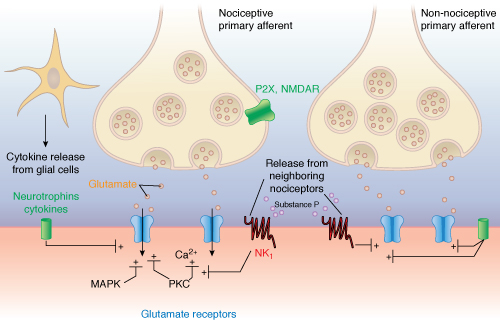The Synaptic Mechanism Underlying Peripheral, Nociceptive, Stimuli-Induced, and Persistent Heterosynaptic Potentiation of Dorsal Horn Neurons Transmitters and Mediators Released from Primary Afferents and Surrounding Microglial Cells, Including Substance P, Neurotrophins, and Cytokines May Act at a Distance on Dorsal Horn Neurons to Produce Long-Lasting Heterosynaptic Potentiation of Glutamatergic Transmission. Note that Both Inputs from Nociceptors and Nonnociceptors May Be Potentiated. Mapk, Mitogen-Activated Protein Kinase; P2x, Purinoceptor; Pkc, Protein Kinase C; Nk1, Neurokinin 1 (Substance P Receptor)

(From Reves JG, Fragen RJ, Vinik HR, et al. Midazolam: pharmacology and uses. Anesthesiology. 1985;62:310-324, with permission.)
The synaptic mechanism underlying peripheral, nociceptive, stimuli-induced, and persistent heterosynaptic potentiation of dorsal horn neurons. Transmitters and mediators released from primary afferents and surrounding microglial cells, including substance P, neurotrophins, and cytokines may act at a distance on dorsal horn neurons to produce long-lasting heterosynaptic potentiation of glutamatergic transmission. Note that both inputs from nociceptors and nonnociceptors may be potentiated. MAPK, mitogen-activated protein kinase; P2X, purinoceptor; PKC, protein kinase C; NK1, neurokinin 1 (substance P receptor)